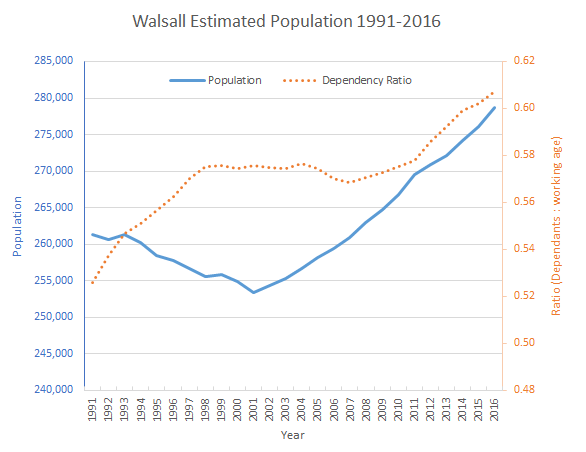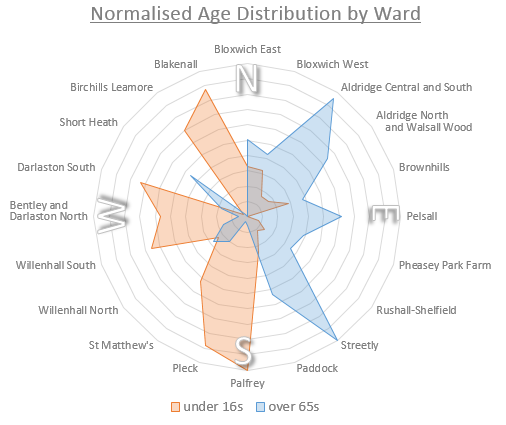Population
Walsall has an estimated population of 286,700 (ONS 2020 Mid-Year Estimates), comprised of approximately 21.7% children 0-15 (62,300), 60.8% working-aged 16-64 (174,300), and 17.5% 65 years & over (50,100), giving a dependency ratio of 0.64 dependents to every 1 working age adult. In terms of density, this equates to around 2,757 people per square kilometre. The population has seen a 7.45% increase over the past decade, from 266,800 in 2010: most of this increase has been under 16s, increasing by 12.2% & over 65s growing by 10.2%, contrasted to a working age (16-64 years) increase of around 5.1% (2020 & 2010 ONS Mid-Year Estimates).
Projections
Walsall is expected to see continued & consistent population growth, projected to increase by 7% to an estimated 304,400 by 2030 & further by 13% to an estimated 320,400 by 2040 (2020 ONS, 2018-based projections). The largest increases are expected within older age groups; the population over 65 years of age will increase their share of the population from approximately 18% to 20% by 2040 (around a 1% decline in population share for both children & working-age adults). There has already been an 8.8% increase in births in Walsall between 2004 and 2014, and the number of Walsall of reception pupils in Walsall schools has increased 11.34% between 2012 and 2017.
Therefore, planning to meet the needs of a growing number of a younger population as well as a growing number of older people is incorporated within our key strategic priorities, while recognizing that the proportion of residents likely to be economically active is projected to fall.
Dashboard
The interactive dashboard can be filtered in a variety of ways: clicking on the Ward, setting the age range & selecting sex.
Historical Changes
Walsall's population has changed significantly over time. The below graph shows the change between 1991-2016 in estimated population. In 90s - 2000s Walsall's population was in decline, reaching a minimum in 2001. This was predominantly a fall in the working age population, as reflected in the dependency ratio: defined as the number of dependents, under 15 or over 65, to every 1 working age adult. Since 2001 the population has risen significantly - 9% in 15 years. The dependency ratio has continued to rise, in-line with population, and above the national average - accounted for by a continued rise in the elderly population.

Source: ONS Mid-year estimates
Population Distribution
The below graph shows an overview of the concentration of young & older people across the borough's wards. The data has been normalised in order to rank the boroughs based on how they compare to one another I.e. Palfrey has the highest under 16s population and so appears furthest from the centre of the chart. Wards with the smallest populations will appear closer to the centre (e.g. Pelsall under 16s).
We can see a clear picture: Streetly ranks top of the over 65s category, closely followed by Aldridge, then Pelsall: the distribution is very much focused in the East. These are the more affluent areas of Walsall.
In contrast, the younger population is focused predominantly in areas within the North, South & West: Palfrey, Blakenall & Pleck - typically more deprived wards.

Source: ONS Mid-year estimates
